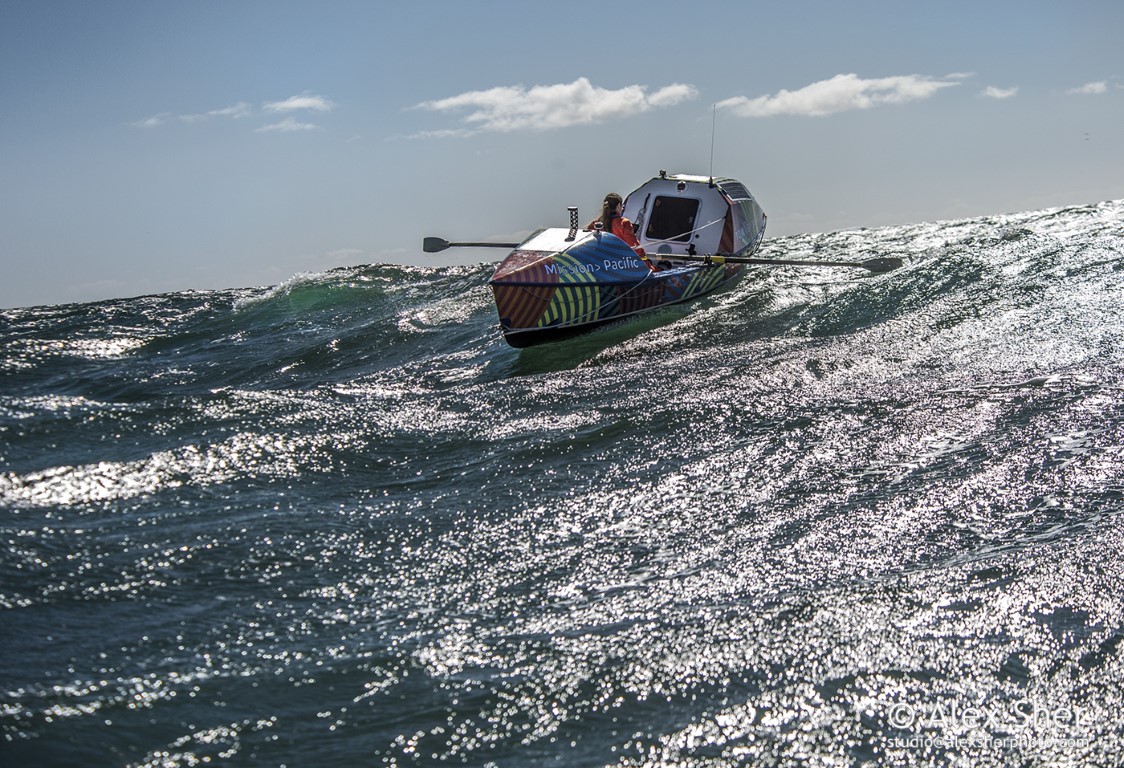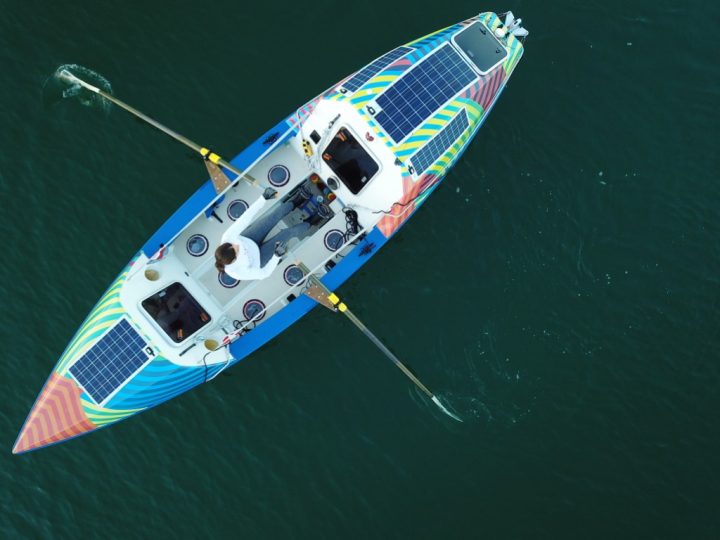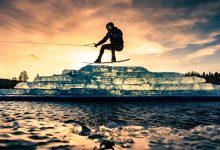
Aurelia Ditton (born 1980 in London), known as Lia Ditton, is a professional sailor, ocean rower, motivational speaker and conceptual artist, now based in San Francisco, California.
Ditton is a successful solo long-distance yachtswoman. In her first solo crossing of the Atlantic, aged 25, Ditton was the youngest competitor and only woman to finish the Single-Handed Trans-Atlantic Race in 2005. Ditton crossed the finish line 4th in the multihull class after 27 days 9 hours 19 minutes at sea.
In 2020, Ditton set a new women’s world record for rowing solo from the US mainland to Hawaii. She completed the journey in 86 days and 10 hours.[3]
Early Life and rowing
- How did you get into ocean rowing? How did it all start for you?
A Danish Olympic was given my number by a mutual friend. ‘Me? Row an ocean? You haven’t even met me!’ I still laugh at the memory of my phone call with Lisa Kroneberg. I started reading books about people who rowed oceans – there were a total of 8 on the subject at the time. I became fascinated. Within months I had committed to row the Atlantic.

Rowing and story specific
- Rowing round the Farallon Islands was something that you were determined to do. Why is rowing round the Farallon Islands so challenging?
The Farallon Islands are a chain of gnarly-looking volcanic islands situated 26 miles west of the Golden Gate Bridge of San Francisco. The islands are a wildlife sanctuary prohibited to humans – a breeding ground for elephant seals in the spring and a shark feeding ground from May to October.
A sequence of weather events need to line up favourably in order to reach the Farallon Islands in a rowboat – a strong outgoing tide and a weak incoming tide and either a break in the wind or an easterly/north-easterly breeze (which is rare). The islands are right on the lip of the continental shelf and subject to huge swells, which have killed many sailors in the past.
- Conquering the row around these islands was a huge milestone in your rowing career. Can you talk us through the three attempts you made? What was going through your mind after you failed the first attempt? What motivated you to continue for another two?
I proved it was possible to reach the Farallon Islands in my boat, when I turned back 2.5 miles shy of the Southeast Farallon Island on my reconnaissance mission. My first official attempt was foiled due to the marine layer, a wind-fog phenomena caused by a temperature differential between land and sea. The experience felt humiliating because of how much media coverage the attempt received (everyone loves a story of aiming big and coming up short). My second attempt ended with another battle with the wind fog, but it’s possible I might have been able to break through the marine layer if I had deployed my sea anchor when I went to sleep. I didn’t, so I’ll never know! My third attempt was in October after I had rowed 350 miles down the coast from San Francisco to Santa Barbara. I had that row in the bank, was willing to be patient for the right conditions and when the weather presented a perfect window I dropped everything and went for it!
- How much did achieving your row around the Farallon Islands impact your confidence in your attempt to row the Pacific?
I feel that rowing around the Farallon Islands was an accomplishment in its own right. The main take-away for me, was never give up. In the end I think my perseverance to succeed was more note-worthy than the feat itself.
- You spoke a lot about your mentality during your rows. How do you keep yourself motivated when you’re struggling?

I try and think of the bigger picture – the education programme for 4-11 year old children who are following along as well as my amazing family of Believers who contribute monthly on my crowdfunding platform Patreon.com/rowliarow. My Believers are terrific at offering encouragement.
Life on the boat
- Can you chat to us about your boat? How does it work/ where do you sleep/ what does it look like? What technology is there on board?
My boat is a 21-foot ocean rowboat with a cabin at one end and a storage compartment at the other. I row on a sliding seat. I have a Katadyn desalination unit onboard, which enables me to convert seawater into drinkable water, a GPS antenna to determine my position and AIS (automatic identification system) to see other ships and for them to seem me. My YellowBrick tracker shows you where I am on my website and to communicate I use a Garmin InReach satellite device that enables me to send text messages using my iPhone.
- What is it like on your boat, during a storm? Do you feel safe? What goes through your mind?
Storms don’t usually appear out of nowhere. The sky changes, the waves build. You know something is coming. Hopefully this gives you enough time to get ready – tidy up, tie down any lose items, make food, wash. As the storm arrives, the important thing is to monitor how the boat is riding the waves and make frequent equipment checks. I have faith that my boat is designed to withstand the conditions, but storms are still stressful because no storm is the same. It’s hard to sleep, but even harder to eat and use the toilet bucket!
Training
- What is your training regime like?
I try and do as much of my training in my boat as possible. Nothing beats doing the thing you’re training for! Off the boat, I swim once a week with a full-face mask so I breathe through my nose and train my diaphragm. I do Bikram (hot) yoga for a serious stretch and a minimum of 2 strength and conditioning workouts in the gym.
- You mentioned your diet is completely different whilst you’re preparing for a row, to what it’s like normally. Can you talk us through that?
I expect to lose up to 23KG while rowing the Pacific and so have been trying to gain as much weight as possible, preferably muscle. I have succeeded in packing on 13.6KG! To achieve this I cover everything I eat in oil and lean towards calorie-rich foods like Parmesan cheese and dark chocolate.
Preparation for the Pacific
- What initially made you want to attempt a solo crossing of the Pacific?
I met a man who had just completed a row of the North Pacific with a rowing partner. His rowing partner said the crossing couldn’t be done solo. Two French men had come close rowing solo in 1991 and 2005, but both had been towed the last 20 and 50 miles respectively to land.
- You said that everything you’ve done up until this point has been, in essence, training for your attempt to row the Pacific. How do you feel your rowing experience up until this point has prepared you for the Pacific crossing?
To date, I have rowed 2,067 miles in training. By the time I ship my boat to Japan, I am hoping to have rowed the equivalent of half the Pacific (3,000 miles). Time on the water breeds experience and with experience confidence develops.
- What would you say is the most important thing you’ve learned, that you’ll take with you into your attempt to cross the Pacific?
I have been through so many trials just to get to the point of departing on my trans-Pacific record attempt. Above all else, I have learned humility. Anything can and will happen and my job is to stay grounded and persevere through the storms and the calms.
- What are you most worried about?
Not being able to give the row a go – through lack of finance, bureaucracy getting my boat to the start line or an issue I can’t even imagine right now.
Life after the Pacific Crossing
- What advice would you give someone who was just getting into ocean rowing?
All of it is part of the adventure – preparing the boat, raising the money, recruiting volunteers and managing sponsors. The row is the pay off at the end – be sure to open your eyes and soak up the beauty of the ocean. You don’t know when you’ll be out there again.
- What advice would you give someone, attempting an expedition like the ones you do?
A positive attitude is the most critical thing you need if you end up in a liferaft. The same goes for getting through the highs and lows of preparing and fundraising for an expedition!
To read more about Lia’s story and Pacific attempt, click here.








